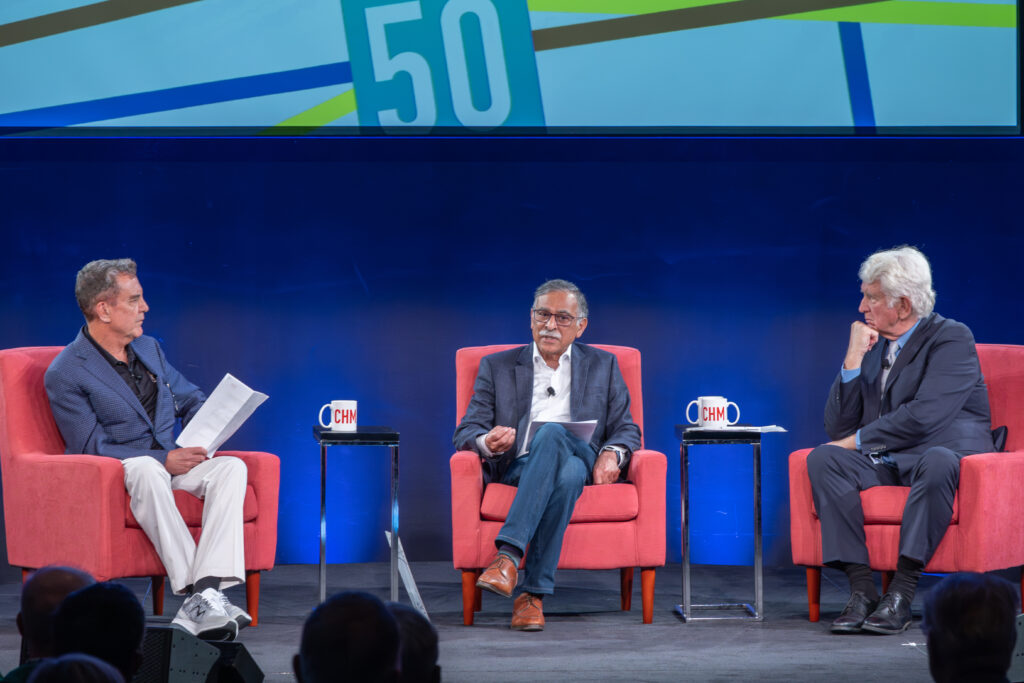
Ethernet transformed how we connect to each other and to the world. On May 22, 2023, CHM celebrated Ethernet’s 50th anniversary with co-inventor of Ethernet Bob Metcalfe, a 2008 CHM Fellow and this year’s winner of ACM Turing Award, along with other networking luminaries.

Rich Karlgaard, Yogen Dalal, and Bob Metcalfe on stage at CHM Live.
Forbes’ Rich Karlgaard led the first panel discussion with Bob Metcalfe and Yogen Dalal, a member of the Ethernet development team. In the early 1970s, at Xerox’s innovative Palo Alto Research Center (PARC), Bob was tasked with designing the network for the first personal computer.
When grad student Dave Boggs helped Bob, who had injured himself cutting coaxial cable, the two began to work together and quickly earned the nickname “the Boggsy Twins.” A breakthrough moment came when concerns about violating potential restraint of trade laws by connecting products from DEC, Intel, and Xerox led to making Ethernet an open standard. That strategy allowed for its rapid proliferation.
When Yogen Dalal first heard about Ethernet, his reaction was, “Wow!” a feeling shared by everyone who came across it. He would explain how the creative yet simple technology worked using a cocktail party analogy.
Yogen Dalal explains how Ethernet works.
After a video clip of the late Dave Boggs describing how Ethernet evolved out of the need to connect office workers’ computers together, Bob explained how the monopolies of AT&T and IBM had to be broken to build the internet. Standardization was key, too, in making networking possible. Bob saw the potential for cooperation between DEC, Intel, and Xerox and how to serve the market with Ethernet-compatible products and founded 3Com. Selling Ethernet for IBM PC’s, Bob explains, led to the articulation of “Metcalfe’s Law.”
Bob Metcalfe explains his law.

Rich Karlgaard, Andy Bechtolsheim, and Judy Estrin on stage at CHM Live.
The second panel focused on how networking pioneers capitalized on Ethernet technology, creating a global industry. Rich Karlgaard moderated the discussion with serial entrepreneurs Andy Bechtolsheim, who has been founding and building networking companies for over 45 years, and Judy Estrin, who founded eight networking companies.
From a technology perspective, Judy believes that Ethernet’s success and endurance was due to the simplicity of its design, its flexibility, and the layering that allowed entrepreneurs to build different technologies underneath the packet format. But, there were also other factors that contributed to its success.
Judy Estrin unpacks Ethernet’s success.
Former VP of R&D at DEC Gordon Bell, in a video clip, describes the first meeting with DEC, INTEL, and Xerox at PARC in 1978 to begin creating the Ethernet standard that was ultimately completed in 1980. These standards helped enable the creation of billion-dollar businesses around Ethernet infrastructure. Judy’s Bridge Communications focused on switching, routing, and connecting legacy systems, while Andy focused on building workstations.
Andy Bechtolsheim explores workstation opportunities.
In another video clip, John Chambers, former chairman and CEO of Cisco, shared how he learned to listen to customers like Ford and Boeing who alerted him to fast Ethernet at a time when everyone was betting on AT&T. He got it and Cisco thrived. Similarly, Judy Estrin helped FedEx transition from mainframe to network computing as a board director. But, she was unable to convince Steve Jobs to include Ethernet as an option alongside AppleTalk. Turned off by the bulky component, he said, “Apples only need to talk to Apples.”

Bob Metcalfe in CHM's Revolution exhibit with Ethernet artifacts.
In the third segment of the evening, Bob Metcalfe described how connectivity is an extremely powerful tool, and ones that humans have trouble handling. That results in pathologies, he said, like hacking, pornography, advertising, spam, and fake news. He then gamely answered audience questions on everything from AI to ALOHAnet and the future.
That future includes an Ethernet standard for 800 gigabits per second on optical fiber and 1.6 terabits per second, both with multiple lanes. Fifty years ago, the initial Ethernet was 2.94 megabits per second.
CHM would like to thank Arista Networks and the Ethernet Alliance for their generous support of Ethernet@50.
Ethernet@50 | CHM Live, May 22, 2023
From 1988 to 1994, venture capitalist and historian James L. Pelkey traveled around the world conducting interviews for his hypertext book, A History of Computer Communications: 1968-1988. The transcripts from these interviews contain a wealth of knowledge from early computer communication pioneers. Explore: